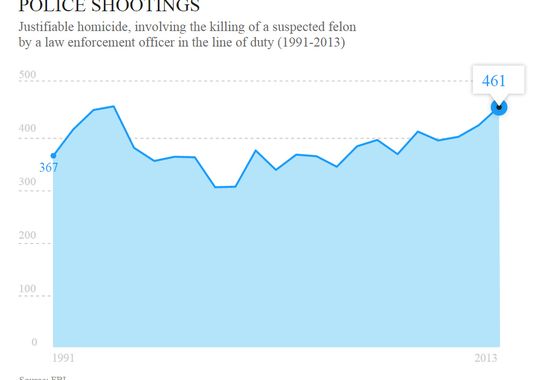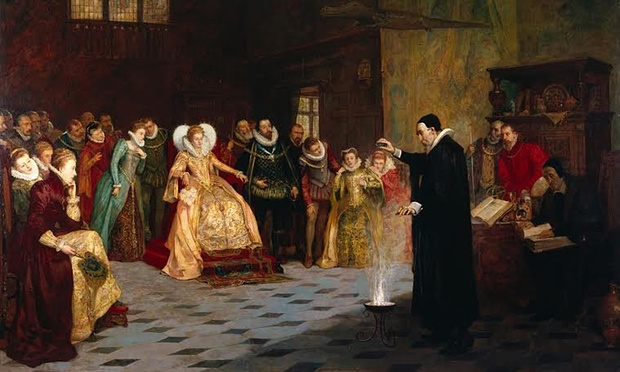The FBI released their annual crime report this week, revealing that the estimated number of violent crimes in the  U.S. decreased 4.4 percent in 2013 when compared with 2012 data. Property crimes also decreased 4.1 percent, marking the 11th straight year the collective estimates for these offenses declined.
U.S. decreased 4.4 percent in 2013 when compared with 2012 data. Property crimes also decreased 4.1 percent, marking the 11th straight year the collective estimates for these offenses declined.
These stats are interesting because the number of people who own legal firearms has significantly increased from 192 million in 1994, to 310 million in 2009, and has continued to increase every year since. However, violent crime for private citizens has been going down.
But the big pink elephant in the room, is the fact that there appears to be an increase in police shootings, scandals and violence. According to another report called the FBI’s annual Uniform Crime Report, 461 felony suspects were shot by police this past year, which was the most amount in two decades.
 These news stories of police on citizen violence have been going viral all over the internet in the last two years with increasing frequency. An example of the aftermath of such events can be seen in places such as Ferguson Missouri with the infamous protests and riots that have been plaguing the city for months. Also this past week, a Saratoga, Florida Sheriff Sargeant, Shawn R. Glans was seen on camera violently slapping a young man who exercised his 4th amendment rights and refused an illegal search. Two day later after the video went viral, the cop was arrested and charged for his crimes by his own department.
These news stories of police on citizen violence have been going viral all over the internet in the last two years with increasing frequency. An example of the aftermath of such events can be seen in places such as Ferguson Missouri with the infamous protests and riots that have been plaguing the city for months. Also this past week, a Saratoga, Florida Sheriff Sargeant, Shawn R. Glans was seen on camera violently slapping a young man who exercised his 4th amendment rights and refused an illegal search. Two day later after the video went viral, the cop was arrested and charged for his crimes by his own department.
So, these are interesting statistics on the state of American violence right now. A time when Americans own more guns than ever, but are less violent, and the police are now becoming more militarized and more violent.
Here are the official stats from the FBI – The FBI 2013 statistics show the estimated rate of violent crime was 367.9 offenses per 100,000 inhabitants, and the property crime rate was 2,730.7 offenses per 100,000 inhabitants. The violent crime rate declined 5.1 percent compared to the 2012 rate, while the property crime rate declined 4.8 percent.
These and additional data are presented in the 2013 edition of the FBI’s annual report Crime in the United States. This publication is a statistical compilation of offense and arrest data reported by law enforcement agencies voluntarily participating in the FBI’s Uniform Crime Reporting (UCR) Program.
The UCR Program collects information on crimes reported by law enforcement agencies regarding the violent crimes of murder and non-negligent manslaughter, rape, robbery, and aggravated assault, as well as the property crimes of burglary, larceny-theft, motor vehicle theft, and arson. (Although the FBI classifies arson as a property crime, it does not estimate arson data because of variations in the level of participation by the reporting agencies. Consequently, arson is not included in the property crime estimate.) The program also collects arrest data for the offenses listed above, plus 20 offenses that include all other crimes except traffic violations.
Prior to 2013, the FBI’s UCR Program collected rape data in the Summary Reporting System under the category “forcible rape.” In 2013, the program removed the term “forcible” from the title and revised the definition. The legacy UCR definition of rape is “The carnal knowledge of a female forcibly and against her will.” The revised UCR definition of rape is “Penetration, no matter how slight, of the vagina or anus with any body part or object, or oral penetration by a sex organ of another person, without the consent of the victim.”
A total of 18,415 city, county, state, university and college, tribal, and federal agencies participated in the UCR Program in 2013. A summary of the statistics reported by these agencies, which are included in Crime in the United States, 2013, follows:
- In 2013, there were an estimated 1,163,146 violent crimes. Each of the violent crimes show declines (murder and non-negligent manslaughter—4.4 percent, rape [legacy definition]—6.3 percent, robbery—2.8 percent, and aggravated assault—5.0 percent) compared with estimates from 2012.
- Nationwide, there were an estimated 8,632,512 property crimes. The estimated numbers of each of the property crimes also show declines when compared with the previous year’s estimates. Burglaries dropped 8.6 percent, larceny-thefts declined 2.7 percent, and motor vehicle thefts were down 3.3 percent.
- Collectively, victims of property crimes (excluding arson) suffered losses calculated at an estimated $16.6 billion in 2013.
- The FBI estimated that agencies nationwide made about 11.3 million arrests, excluding traffic violations, in 2013.
- The arrest rate for violent crime was 159.8 per 100,000 inhabitants, and the rate for property crime was 513.2 per 100,000 inhabitants.
- By violent crime offense, the arrest rate for murder and non-negligent manslaughter was 3.4 per 100,000 inhabitants; rape (aggregate total of revised and legacy), 5.5; robbery, 32.0; and aggravated assault, 118.8 per 100,000 inhabitants.
- By property crime offense, the arrest rate for burglary was 82.9 per 100,000 inhabitants; larceny-theft, 405.5; and motor vehicle theft, 21.4. The arrest rate for arson was 3.4 per 100,000 inhabitants.
- In 2013, there were 13,051 law enforcement agencies that reported their staffing levels to the FBI. These agencies reported that, as of October 31, 2013, they collectively employed 626,942 sworn officers and 275,468 civilians, a rate of 3.4 employees per 1,000 inhabitants.
Caution Against Ranking
Each year when Crime in the United States is published, some entities use the figures to compile rankings of cities and counties. These rough rankings provide no insight into the numerous variables that mold crime in a particular town, city, county, state, tribal area, or region. Consequently, they lead to simplistic and/or incomplete analyses that often create misleading perceptions adversely affecting communities and their residents. Valid assessments are possible only with careful study and analysis of the range of unique conditions affecting each local law enforcement jurisdiction. The data user is, therefore, cautioned against comparing statistical data of individual reporting units from cities, metropolitan areas, states, or colleges or universities solely on the basis of their population coverage or student enrollment.
– Crime in the United States, 2013

Moe is the founder of GnosticWarrior.com. He is a father, husband, author, martial arts black belt, and an expert in Gnosticism, the occult, and esotericism.









